The world's first black watch, Porsche Design's "Chronograph 1 by Orfina," was also used in Top Gun
Click here to watch the video of the Orfina watches used in Top Gun.
The movie Top Gun: Maverick is currently a huge hit, and many people are curious about the watch worn by Lt. Mitchell in the film.
In this article, we will provide a thorough explanation of the watch worn by Captain Mitchell in Top Gun.
The table of contents is as follows:
1. What is Chronograph 1 by Orfina? A simple explanation
2. Relationship between Porsche Design and Orfina
3. What is Valjoux’s masterpiece, Cal. 7750?
4. World's first! PVD coating creates a black watch
5. Adoption of automatic chronograph movements despite the impact of the quartz crisis
6. Change the design
7. Differences between general and military specifications
8. Orfina Porsche Design Chronograph 1 used in famous scenes
The story behind the birth of the Orfina Porsche Design Chronograph 1

There is a saying that "necessity is the mother of invention."
Ferdinand Alexander Porsche, also known as "Buzzi", is the designer of the Orfina by Chronograph 1 used in the film.
When the Porsche Design and Orfina Chronograph 1 was first launched in 1972, it fundamentally redefined what was meant by the sports chronograph.
The all-black dial features white numerals and subdials, and a red seconds hand, making it look just like the speedometer and tachymeter on the dashboard of a Porsche 911.
The large tachymeter with numbers around the dial is covered with crystal.
・30-minute counter at 12 o'clock
- 12-hour counter at 6 o'clock (used during endurance races)
・Second hand at 9 o'clock
are located here.
The date and day of the week are visible through two windows at the 3 o'clock position.
As a sports chronograph, this is more than enough information to read.

The first black watch: the Orfina Porsche Design Chronograph 1
This is a clock like this, but if you don't have any knowledge about it, you won't understand the meaning of its name, so I'll give a brief explanation.
Porsche Design and Orfina
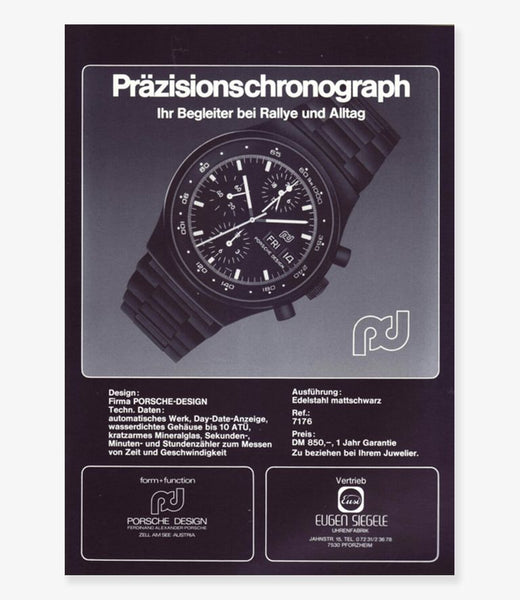
Of course, Porsche is a car manufacturer, not a watch manufacturer.
Porsche Design is a company that is derived from Porsche and designs accessories and other items.
So we chose a Swiss company called Orfina to collaborate with to create the watch.
The Orfina was owned by the Italian racing driver Umberto Maglioli, who, as you might imagine, drove for Porsche until his retirement.
So, in addition to being a racer, Umberto is also the president of a company called Orfina.

Among the products produced in this way, early models had the word "ORFINA" above the date and day of the week displays, while later models had the Porsche Design logo, PD, in that location.
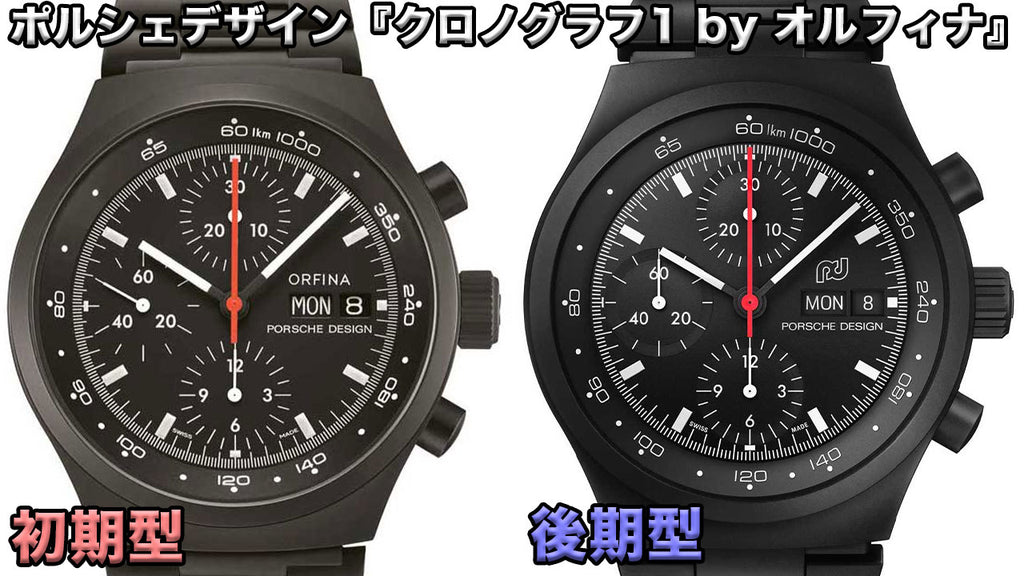
Additionally, the word "Porsche Design" appears beneath the date and day displays.
The Porsche Design Chronograph 1 is a very important watch historically.
This is because it was the first ever serially produced black watch, complete with a jet-black bracelet.
(You could also opt for the version on a bead-blasted steel bracelet).
What is Valjoux's masterpiece, Cal. 7750?
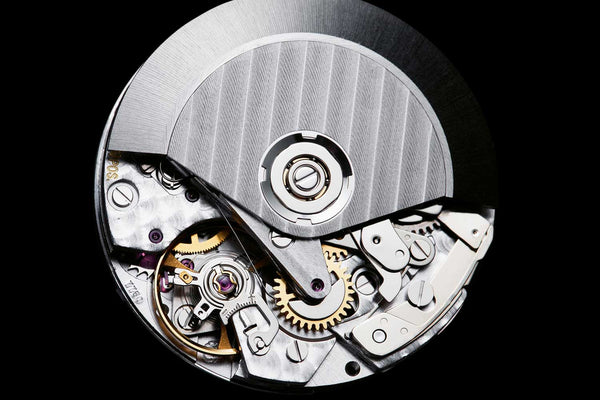
The Legendary Valjoux 7750
Now let's take a look at the movement inside this watch.
The ability to display all this information, while also having a vibration speed of 4 Hz, making it possible to create a chronograph that is highly accurate, reliable, and has excellent winding efficiency, was made possible thanks to the entirely new movement, the Valjoux Cal. 7750.
The Valjoux Cal. 7750 was designed by a talented engineer named Edmond Capt.

Following the release of the Zenith El Primero and the chromatic Cal. 11 in 1969, Valjoux commissioned Capt to create a technically advanced automatic chronograph movement.
Capt owned the patents for the Chronomatic, purchased them from Buren and created his own new movement.
For details on the evolution from Cal.11 to Cal.7750, please watch this video:
First, the design started based on the manual winding Cal.7733 movement, and by using computer technology, which was still cutting edge at the time, they succeeded in creating a movement with a rectangular cam instead of a column wheel, which made it possible to mass-produce it cheaply and easily (because the design and manufacturing processes were significantly revised).
Although the Porsche Design Chronograph 1 was "announced" in 1972, the first finished samples didn't actually reach buyers until 1973.
However, this was the world's first watch to feature the groundbreaking new movement, the Valjoux Cal. 7750, and it was also the first sports chronograph to feature a date and day of the week display.
Not only the exterior, but the movement as well conveys that a great deal of effort has gone into it.
A world first! PVD coating creates a black watch
Three years ago, Seiko introduced the Astron, bringing about the quartz crisis, but FA Porsche decided to create a chronograph equipped with this new movement.
We also insisted on using a new surface coating called "physical vapor deposition," or PVD, which had never been used on a watch before.
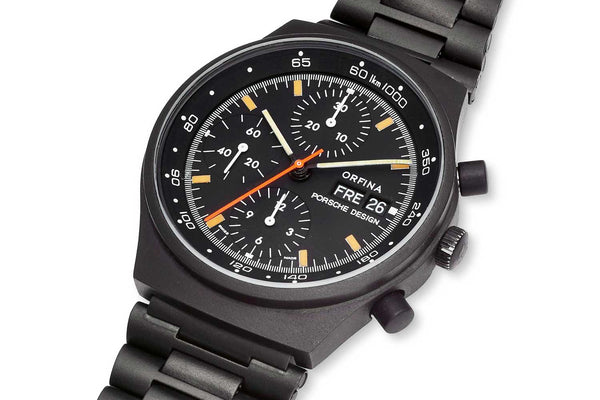
Early models with the Valjoux 7750 have the word "Orfina" above the date/day display instead of a logo. (From Christies Online)
Nowadays it's common to see black watches, but in 1972 a black watch was quite a shock.
FA Porsche originally experimented with other surface treatments, such as automated painting techniques, but in the end the only method that proved satisfactory was PVD coating, which is the vapor deposition of metal onto the exterior of the watch.
Although this technology was conceived as early as 1852, it was not until 1968 that it was finally perfected.
Compared to today's DLC coatings, it is more prone to peeling off, but at the time it was a fairly revolutionary coating.
As a bit of trivia, the difference with DLC coating is the size of the particles.
In short, PVD has larger particles, so it adheres poorly and peels off easily.
What a visionary designer he was, FA Porsche used PVD on his watches 20 years before Panerai applied this treatment to the Pre-Vendome Luminor Marina.
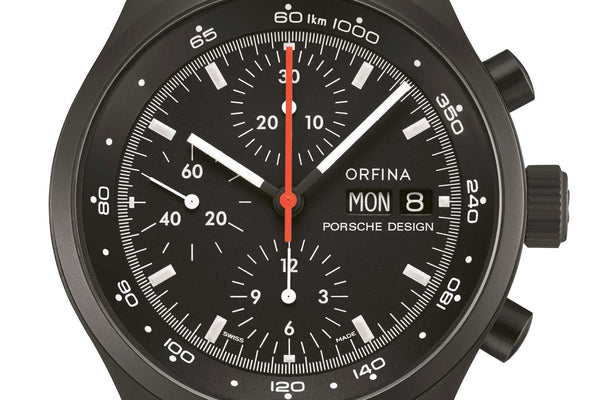
Adoption of automatic chronograph movements despite the impact of the quartz crisis
Let's also take a look at the situation when this chronograph was released in the early 1970s.
However, in 1975, FA Porsche found itself in a situation where it was forced to redesign the watch.
Valjoux was devastated by the quartz crisis and ordered designer Edmond Capt to scrap everything related to the Valjoux Caliber 7750.
In response to this, Edmond Capt decided to hide all of his production tools instead of abandoning them, just as Zenith's Charles Vermot had hidden the tools used to make the El Primero.
This gives you an idea of how urgent the production of mechanical watches was during the quartz crisis.
Surprisingly, however, FA Porsche took a risk and gambled on continuing with mechanical chronograph movements rather than switching over to quartz.
(So there is a company called Valjoux that only makes movements, and there are companies called Orfina and Porsche Design that are in charge of exteriors and design.)
With the supply of the Valjoux Caliber 7750 movement halted (it would not be revived until 1984 by Theodor Schneider in the Breitling Chronomat), FA Porsche and Maglioli turned to another watch movement manufacturer called Lemania for supplies.

Models equipped with the Lemania 5100 have a 24-hour counter at the 12 o'clock position. ( From Watchpool24 )
From the Valjoux Caliber 7750 to the Lemania Caliber 5100
Thus, the Lemania Caliber 5100 was born in 1974, taking over from the Valjoux Caliber 7750, and when it was released it was so brilliant that it was like a savior from another world.
Specifically, the Lemania Cal. 5100 was created to be a very inexpensive movement that was reliable, shock-resistant, and had an easy-to-read dial.
Therefore, rather than rolling simple bridges and plates, parts were punched out.
In addition, it makes maximum use of a high-performance plastic called Delrin.
Within this movement, Delrin is used for the date and day wheels, switching cams, and chronograph clutch plate.
Even the balance wheel was made with a shock-absorbing Delrin plate, and Delrin cushioning was placed around the movement to isolate it from the exterior of the watch, ensuring that any impacts to the exterior of the watch would not be affected.
The movement was also equipped with a vertical clutch, which permanently prevented any adverse effects on isochronism.
The rotor is fixed to a hard iron bearing by a pusher.
Like the Valjoux 7750, the Lemania 5100 is decidedly modern, beating at 4 Hz and featuring quickset date and day.
These specifications mean that even if you were to use your Lemania 5100-equipped chronograph on a desert island to smash coconuts and seashells, it wouldn't lose any accuracy.
In fact, the Omega Speedmaster uses the Lemania 5100 movement, and Omega expert Chuck Maddox has described the Lemania 5100's exceptional performance as "the ultimate ideal."

Changes to the design
However, the incorporation of the Lemania 5100 had some impact on the dial, which required the Orfina Porsche Design Chronograph 1 to be redesigned with subtle but significant changes.
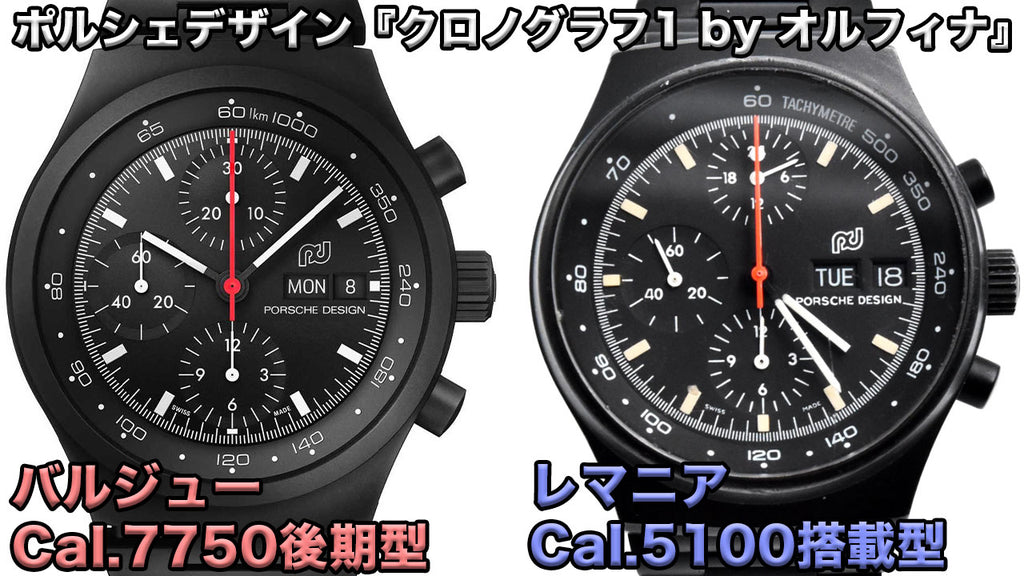
Unlike other movements, the Lemania 5100 has a central minute counter and a chronograph seconds hand mounted on the same axis on a tubular pinion.
The chronograph seconds hand remains red, but the minute counter is now white and uses a lollipop hand, scaled to read the same as the minutes.
What has changed?
・The sub-dial has been changed from km to tachymeter
・The in-dial at 12 o'clock will display the time in 24 hours.
In other words, it is a chronograph that measures 60 minutes.
These modified watches (specifically 7177 and 7178) also share the same name, Porsche Design Chronograph 1, so it's easy to get confused.
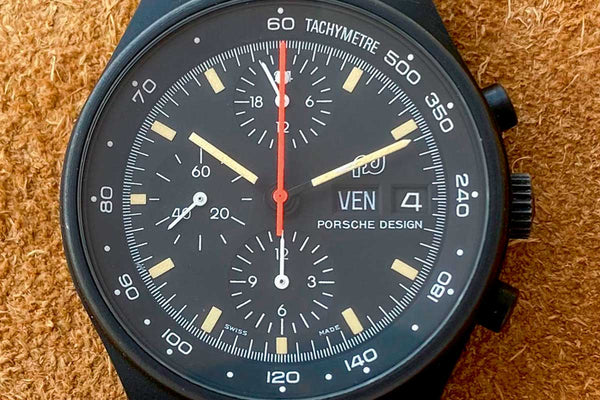
Differences between general and military specifications
It's worth noting that these Porsche Design chronographs also came in military versions made for various air forces, including the West German and NATO armies.
One key visual difference is that the military version's minute hand has a black base and a crimson red tip that resembles an airplane.
Military watches have the word "military" instead of the PD logo.
Furthermore, since it is intended for use in a cockpit, the sub-dials display 12 hours instead of a tachymeter to make it easier to read the time.
It also basically comes with two leather belt straps instead of a bracelet.
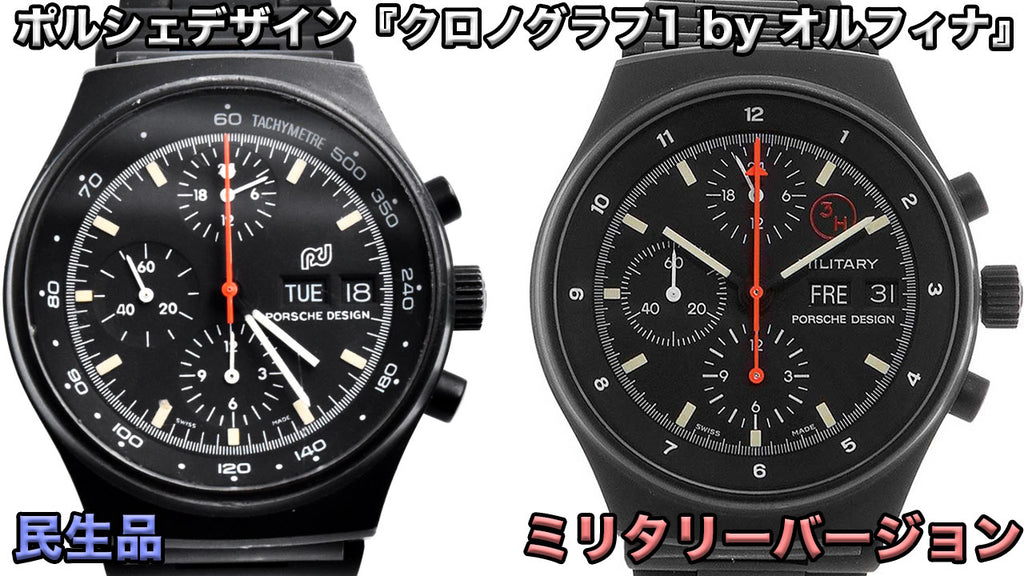
Furthermore, the military version of the Porsche Design Chronograph 1 does not have the Valjoux Caliber 7750, and all are equipped with the Lemania Caliber 5100.

The military version has a black base and a red tip on the chronograph minute hand, shaped like an airplane. (From A Collected Man)
Orfina produced the Porsche Design Chronograph 1 from 1972 to 1978.
Among these, the switch from the Valjoux Caliber 7750 appears to have occurred between 1974 and 1975, around the time the Lemania Caliber 5100 was released.
In 1978, Porsche Design began a collaboration with IWC that resulted in the creation of a watch as famous as the Orfina Porsche Design.
But the Orfina watch is all the more special in that it was the first watch made by FA Porsche and it contains two of the most important movements ever made.
Orfina Porsche Design Chronograph 1 used in famous scenes
The Porsche Design Chronograph 1 was seen starring in films such as "Kramer vs. Kramer" by Dustin Hoffman, "The Professionals" by Martin Shaw, and most famously, worn by Tom Cruise in "Top Gun."
The choice of this watch to be worn by Navy Captain Pete "Maverick" Mitchell was a fitting one, considering that Lemania-equipped versions of the chronograph were in fact the official military equipment of choice for air forces around the world.
(However, the watch worn by Tom Cruise in the film is not the military version, but the civilian version with a tachymeter.)
And the Porsche Design watch worn by Maverick in Top Gun 1 has been carefully kept by producer Jerry Bruckheimer for 34 years since filming of Top Gun 1 ended, and Tom Cruise can be seen wearing it again in the new Top Gun: Maverick, which will be released this year.

Tom Cruise, who plays Navy Lt. Pete "Maverick" Mitchell in the film "Top Gun," wears a black Porsche Design chronograph. (via Getty Images)
However, it can be said that Mario Andretti, the legendary F1 racer, has built a career that is more suited to the Orfina Porsche Design Chronograph 1 than Tom Cruise.
Andretti wore a self-purchased Orfina Porsche Design Chronograph 1 throughout the 1978 season.
However, after the Brazilian Grand Prix ended, I went for a walk on Ipanema Beach and took a nap there.
Then, while he was sleeping, his beloved Porsche Design Chronograph 1 was stolen.
As soon as word reached FA Porsche and Umberto Maglioli, a new watch was sent to Andretti.
Andretti wore the watch to five more first place finishes during the season, and also wore it when he was crowned F1 champion at Monza.
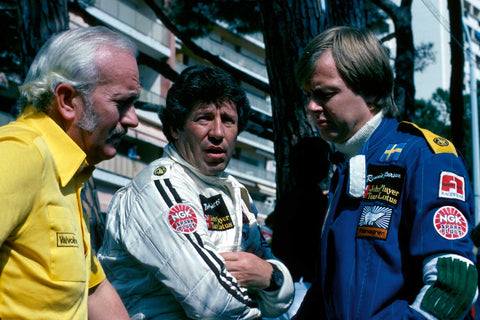
F1 racing legend Mario Andretti wears the Orfina Porsche Design Chronograph 1. (Getty Images)
Half a century has passed since the birth of this wonderful watch, and FA Porsche's lofty vision and its determination to stick to mechanical watches even in the difficult circumstances of the quartz crisis continue to grow.
Surprisingly, watches designed by FA Porsche can still be purchased today at relatively affordable prices.
Both the Valjoux and Lemania models are priced between 400,000 and 520,000 yen, with the military models costing about 25% more than that, but still available to purchase.



